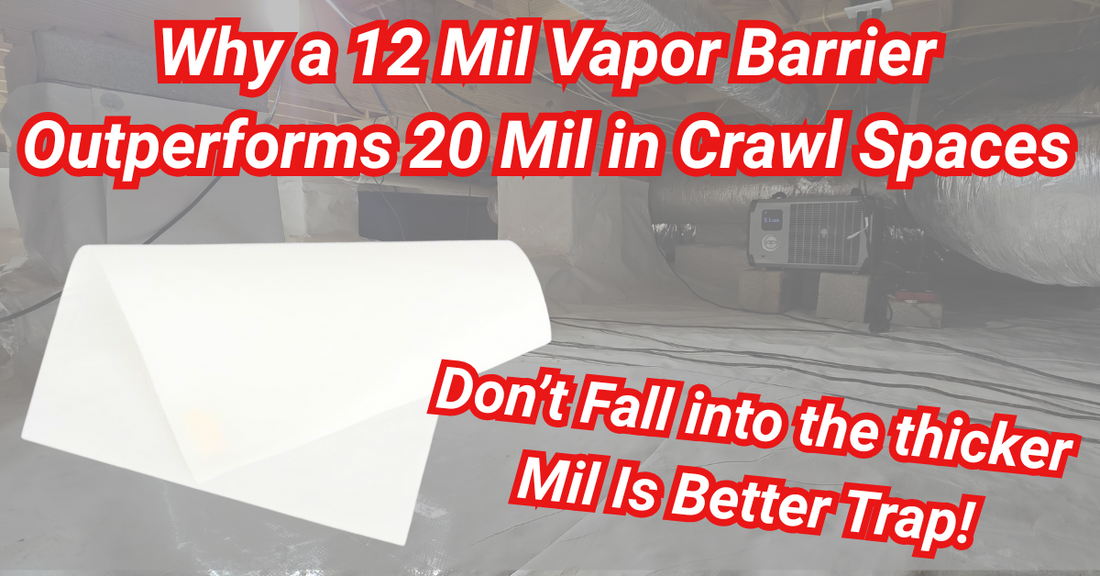Why a 12 Mil Vapor Barrier Outperforms 20 Mil in Crawl Spaces
AJ Howard
Hi, I’m AJ with Crawl Space Ninja Supply, and I want to clear up one of the biggest myths I hear from homeowners and contractors:
“Thicker vapor barriers — like 20 mil or higher — must be better.”
It sounds logical, right? Thicker plastic should mean stronger protection. But after years of working in crawl spaces and even redoing competitor jobs, we’ve learned the opposite.
Our 12 mil solid polyethylene vapor barrier is more efficient, cost-effective, and durable in real-world crawl space conditions. Let’s break down why.
The Problem With Higher Mil Vapor Barriers
Once you hit the 20 mil mark (and higher), vapor barriers stop being practical for crawl spaces.
-
Too stiff and rigid — Hard to bend around piers, corners, and tight spots. That stiffness leads to sloppy installs and weak seals.
-
Layered construction — Most 20 mil barriers aren’t solid sheets; they’re multiple thin layers glued together. Over time, adhesives separate.
-
The odor issue — When those layers peel apart, they release a foul smell. Homeowners often describe it as a “cat urine” odor that fills the crawl space.
A Real-World Example From Michael Church
Michael Church, owner of Crawl Space Ninja, inspected a Chattanooga home where a competitor had installed a reinforced vapor barrier just a few years earlier. On paper, it seemed like a premium setup:
-
12 or 20 mil reinforced barrier
-
Mechanical wall attachments
-
Atmox ventilation system
But here’s what Michael found during his inspection:
-
Humidity at 77% — far too high (safe levels are below 60%).
-
Fungal growth spreading on joists and wood supports.
-
High wood moisture content feeding mold growth.
-
Walls and rim joists left uninsulated, allowing constant heat transfer.
-
And worst of all the strong cat urine odor coming directly from the reinforced vapor barrier.
The homeowners tried fans, odor eliminators, and follow-ups with their installer. Nothing worked until the 20 mil barrier was removed and replaced.
This case proves that thickness alone doesn’t equal performance. Material choice, flexibility, and moisture control matter most.
Why Our 12 Mil Vapor Barrier Works Better
Here’s why we stand behind our 12 mil solid polyethylene vapor barrier:
-
One solid sheet — No adhesives, no peeling layers, no odor.
-
Flexible in tight crawl spaces — Easy to wrap around piers and corners for a true seal.
-
Durable under real conditions — Holds up to storage, foot traffic, and contractors working in the space.
-
Cost-effective — You’re not paying for unnecessary bulk or gimmicky “extra mils.”
This 12 mil barrier hits the sweet spot: strong, flexible, odor-free, and long-lasting.
The “Bigger Is Better” Gimmick
Contractors love to pitch 20+ mil barriers as the “premium” option. But it’s marketing spin.
It’s like buying a $100,000 truck just because you might need to tow something someday. In reality, that overkill doesn’t make sense for most homeowners — and in crawl spaces, it often creates more problems than it solves.
Frequently Asked Questions
Q: Is a thicker vapor barrier always better?
A: No. Thicker barriers are harder to install, less flexible, and prone to odor problems when adhesives break down.
Q: Won’t a 12 mil tear easier than a 20 mil?
A: Not ours. Our 12 mil is a solid sheet of polyethylene. It’s flexible enough to install perfectly and durable enough to handle foot traffic and storage.
Q: Why does a 20 mil barrier smell like cat urine?
A: That smell comes from adhesive layers breaking down inside reinforced barriers. Once they separate, the odor seeps into your crawl space.
Q: Is 12 mil enough for full encapsulation?
A: Absolutely. Our 12 mil has been proven in thousands of encapsulation jobs. It’s strong enough for long-term durability without the downsides of multi-layer products.
Q: Why insulate crawl space walls if I already have a barrier?
A: Because the real heat transfer happens through your foundation walls. Wall insulation, paired with a vapor barrier and dehumidifier, gives you complete protection.
Final Thoughts
The idea that “more mil equals more protection” is a myth that doesn’t hold up in the field.
We’ve seen 20 mil vapor barriers fail time and time again stiff installs, odor problems, high humidity, and frustrated homeowners.
Our 12 mil solid polyethylene vapor barrier is the smarter choice: flexible, efficient, cost-effective, and proven.
